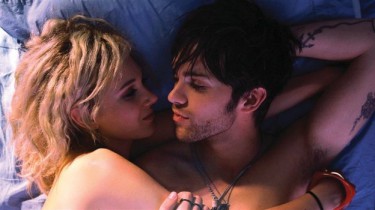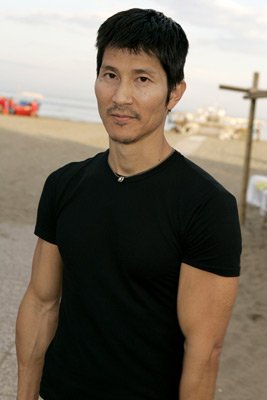 Back to selection
Back to selection
GREGG ARAKI, “KABOOM”

One of the key figures in the New Queer Cinema and ever youthful at 51 years of age, Gregg Araki is a director who is increasingly hard to pigeonhole. After the critical success of 2004’s Mysterious Skin, the film which confirmed that Joseph Gordon-Levitt was a movie-star and that Mr. Araki could direct delicate drama as well as exploitation and cult cinema, it seemed that the director of such indie LGBT classics as The Living End (1992) and The Doom Generation (1995) was moving on to a new, more conventionally respectable, middle-aged portion of his career. Now Mr. Araki is back with Kaboom, a film which stars newcomer Thomas Dekker as a sexually ambiguous college freshman at a coastal California university who may or may not be discovering a plot that will lead to… wait for it… the end of the world!
Getting terrific work out of both Mr. Dekker and up and comer Juno Temple as his sexually adventurous sometimes lover, Mr. Araki’s most recent work is a throwback of sorts, one that recalls the “Teenage Apocalypse Trilogy” that cemented his reputation in the mid 1990’s. Yet while his fast-paced, audaciously absurd film throws everything at the viewer but the kitchen sink, it contains elements that are as personally autobiographical as anything in Araki’s oeuvre. Kaboom bowed out of Competition in Cannes last year before finding its way to Sundance — both the festival and its VOD/theatrical exhibition platform, Sundance Selects, which will release the film in both theaters and on VOD today.

Filmmaker: Do you see this film as an attempt to rekindle some of the anarchic spirit and energy of your “Teenage Apocalypse Trilogy”?
Araki: I didn’t want to regress artistically or anything, but I did sort of in a way wanted to make a sort of old-fashioned cult movie. I don’t think that those movies get made anymore [laughs] given the marketplace and the economy. Frequently when I go to film festival, I’ll run into these kids who are like, “I’ve seen Nowhere like 5,000 times, I had a VHS tape of it and I grew up in North Dakota and that film meant so much to me and it really got me through my adolescence or whatever.” As a filmmaker that’s a huge compliment, it’s sort of the highest compliment that you can get, that something you did meant so much to someone. So I was interested in making a cult movie sort of like that for a new generation. When those movies were made, back in the ’90s, there was no Facebook, there was no internet for the most part, so to this day I don’t really know or understand how those movies really achieved their cult status. It was just theatrical distribution and video; there was no real way to get the word out to people, but I think with the internet and everything else there is so much more potential to reach a broader audience with that kind. And because I don’t think these movies really get made anymore I wanted to do something to fill that void.
Filmmaker: How did you come across Thomas Dekker and what about him provoked you enough to cast him as your lead?
Araki: For this movie, like Mysterious Skin and some of my other films, we just auditioned dozens upon dozens upon dozens of actors. We just wanted to find the best possible actor for each role. Thomas came in, he was actually sort of a fan of mine. I had met him before and he really wanted to be in this movie. It was sort of a dream of his, so it just worked out for this movie that he came in and did an amazing job. There’s something about him that’s so Smith-like, I start to get a picture in my head for all my movies of what the main character will look and sound like and he sort of personified what I had in mind. He did a fantastic job. I think Thomas performance in the film is sort of like Anna Faris’ in Smiley Face — it’s sort of deceptive in that he makes it look a lot easier than it really is. He’s such a great actor from a technical standpoint. The part is very challenging and tricky in that his naturalism and belief in what’s going on that allows the audience in. He plays it with just the right level of seriousness. Since he believes in what’s going on, as preposterous and insane as the story gets, you can go with it. It’s a delicate balance that he’s on and he did a really phenomenal job of it.
Filmmaker: Was that difficult to do, to get him to commit to the material without winking at the audience?
Araki: I’m totally a subscriber to that notion that 90% of directing is casting. It’s really about hiring the right person. People like to say, “well how do you get such a great performance out of Joe Gordon Levitt?” Well, I cast him. [laughs]. I try to work with great actors who are incredibly talented. I’m there to guide them but so much of that creation is theirs.
Filmmaker: Do you see yourself as having thematic preoccupations as a filmmaker that you hope to revisit time and time again at this stage in your career or are you looking for work that is somewhat outside yourself? It seems like this project is a bit of both.
Araki: I’m attracted to all different kinds of material. For me it’s all about, whether I’m writing my own material or finding material from other sources, telling a story that I’m just really passionate about and love. It could be all different kinds of things. Frequently, it’s unexpected, like Smiley Face, I never in a million years thought I’d be making a stoner movie, but when I read that script I just fell in love with it, very much like the way I fell in love with Mysterious Skin when I read the book. So I’m open to all different kinds of material. I feel really blessed in that throughout my career I’ve been able to do all different kinds of movies and haven’t gotten boxed into doing one particular kind of movie. For this movie too, it was about the freedom to be able to do almost anything. One of the things that was so appealing about working on Kaboom was to be able to work on something that was so creative pure and free. It could be all these different genres, and be sort of funny and sexy and scary and be a mystery and have a murder in it and have this crazy scene where someone is trying to blow himself, it has all these different tones and all these different opportunities to just be it’s own kind of thing.
Filmmaker: What were the cult films that spoke to you as a young cinephile, that helped you cope with coming of age?
Araki: David Lynch’s movies. Twin Peaks and the early Jarmusch movie, it’s not really a cult movie but Stranger Than Paradise was hugely influential on me as an undergraduate, [when I was] slightly older than Smith was in the movie. These movies were singular pieces by visionary artists. They were so inspiring to me and so exciting for me as a young film student and aspiring director. The idea that cinema was this art form and that there were authors that were expressing themselves through this medium had a big impact on me in my formative years.
Filmmaker: You’re in your fifties now, but yet you are still drawn to stories of young people. What do you attribute that to?
Araki: After I did the “Teenage Apocalypse Trilogy”, I tried deliberately not to do stories about young people, but the impetus usually comes from someplace else. For instance, after I finished Nowhere in ’96, I didn’t really want to do a teenage movie but then Mysterious Skin came along and I just loved that book so much. Both of the main characters are 18 and going through this sort of painful adolescence, but I loved it and really wanted to do it. This movie is similar in that I didn’t really want to make another movie about teenagers and yet I did want to make a movie about that time in your life. It’s weird to say because the movie is so crazy and has such an insane storyline, but it’s kind of weirdly my most autobiographical movie. [laughs] I really wanted to make a movie about that time of your life when you’re an undergraduate and you don’t know who you are or what your sexuality is or who you’re going to be…
Filmmaker: Smith studies film in the movie.
Araki: Right! The character of Smith is full of things that are based on what I was like when I was that age. I was studying film at the University of California Santa Barbara, the school in the movie is a fictional, seaside, beach town university outside of Los Angeles. My best friend was an art student very much like Stella. The milieu part of the movie is very much drawn from my own experiences. I certainly never had as much sex as Smith has, but I really wanted to capture, more than making a teen movie, what that time in your life is like. That was one of the major impetuses for making this movie.
